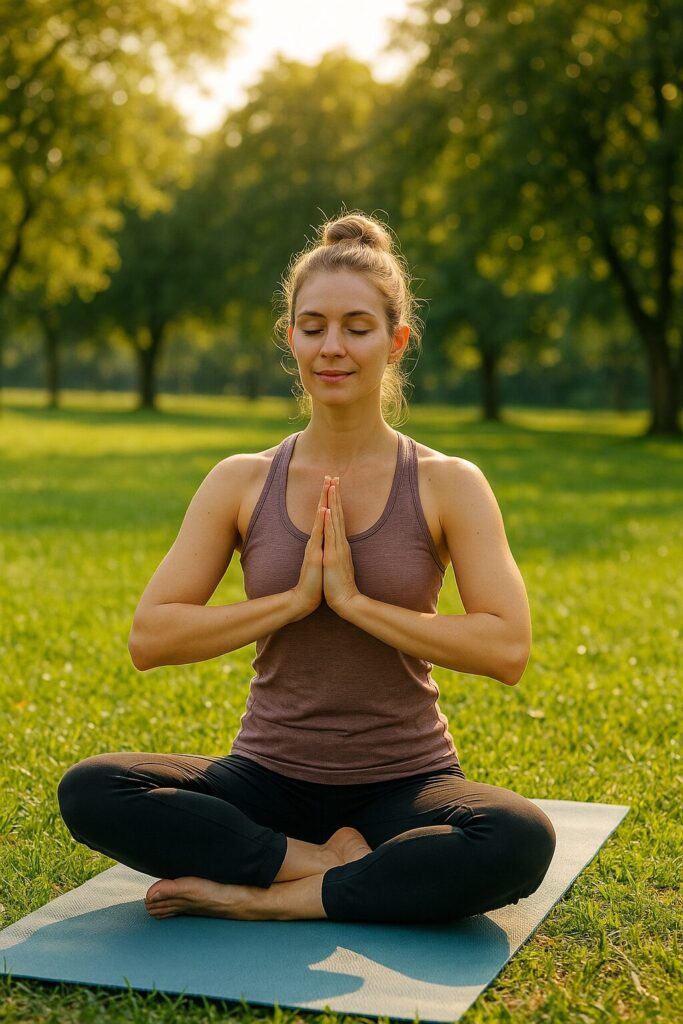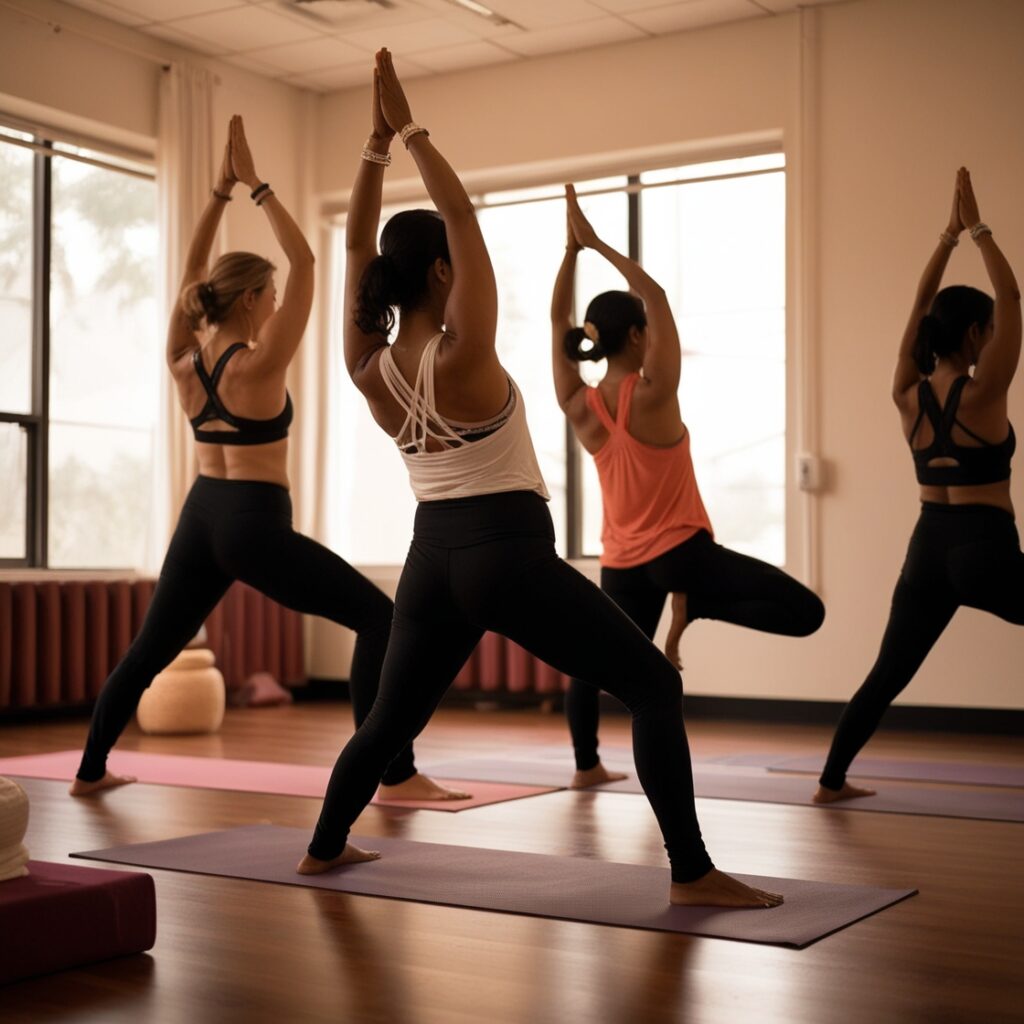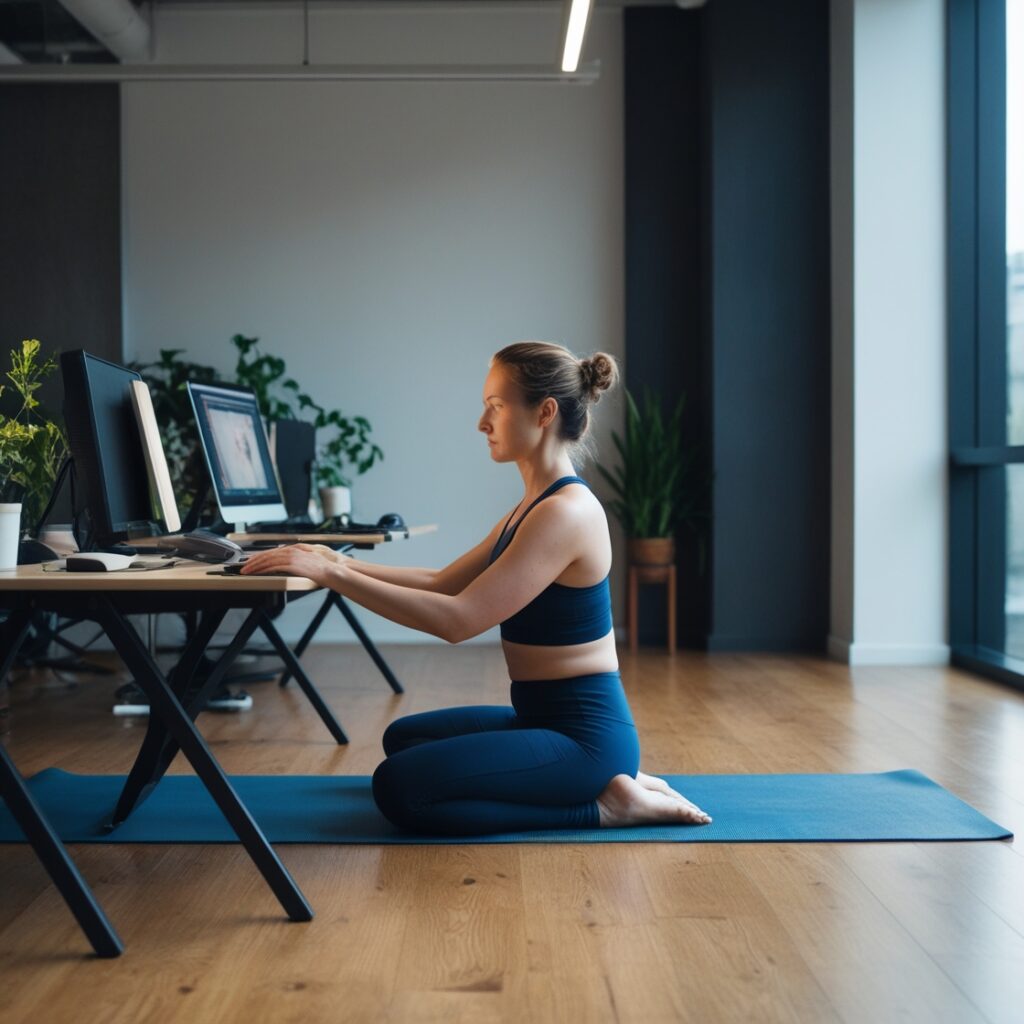YOGA-VS-CROSS FIT FOR WOMEN EXPLAINED- BENEFITS, RISKS AND BEST CHOICE.
Introduction: Women, the backbone of our society, usually find themselves in a dilemma to choose the right choice, Yoga vs. CrossFit, when it comes to fitness. In this fast-paced patriarchal society in the world, women devote the maximum of their time to managing a large part of their household work, including their careers. They don’t find time to look after their health issues. As women juggle careers and personal health, the question becomes more than just about exercise – it is about finding a lifestyle that actually supports long-term well-being.
To choose the right choice between Yoga vs. CrossFit, Yoga promises flexibility, stress relief, and inner balance, and on the other hand, CrossFit delivers a high-intensity workout designed specially for burning calories fast and building lean muscle.
In this Article, we will delve into Yoga vs. CrossFit in simple and practical terms. Whether you are aiming for weight loss, strength, hormonal balance, or just a break from daily stress, here you can decide which fitness path will align with your body’s need and personal goals. Let us uncover the truth behind the battle between Yoga vs. CrossFit.
1. Why the Yoga vs. CrossFit debate matters for women today?
In this fast world, women carry multi-disciplinary responsibilities like managing their careers, household, and personal health. With so many responsibilities in only two hands, fitness for themselves takes a backseat. This is why the debate of Yoga vs. CrossFit comes in, and this has become more relevant for women than ever before.
Most of the women in today’s world face unique health challenges like hormonal imbalance, anemia, stress-related disorders, an increase in body weight, and post-pregnancy recovery. They often try to find ways to come out of these issues.
Sometimes women put themselves in a dilemma on Yoga vs. CrossFit and what to start with. While Yoga offers calmness, balance, and manages hormonal balance while Cross Fit delivers energy, strength, and quick results in weight loss and endurance, and also the Cross Fit extends cardiovascular/endurance, strength, flexibility, power, speed, agility, balance, coordination and accuracy. Not only is this a debate between Yoga vs. CrossFit, but it is also about embracing a yoga-based lifestyle that helps to maintain emotional balance and long-term wellness. On the other hand, the CrossFit lifestyle extends strength, energy, and quick body transformation. Understanding of these approaches will enable women to decide which practice, or combination of these two, will serve their health needs and to achieve their goals.
Instead of blindly following the above trends, here you will get the insights into Yoga vs. CrossFit, their benefits, limitations, and how they fit into different stages in women’s lives. It is your choice, whether your goal is weight loss, stress relief, weight management, strength building, or simply finding time for yourself. Here, you will get a clear understanding of which path will align with your lifestyle.
The purpose of writing this Article is not to declare a Winner in the Yoga vs. CrossFit debate but to empower you with a clear understanding so you can make the best choice for your body, health, and your future.
02. What is Yoga?
The term Yoga is derived from the Sanskrit word “Yuj,” which means to join. Yoga has widely been translated as “Union with the divine” and refers to a number of different spiritual systems. It is the most valuable inheritance of the present. It is the most essential need of this world and the culture of tomorrow.
It is a science of right living, and as such, it is to be incorporated in daily life. It works on all aspects of the person, such as physical, mental, emotional, psychic, and spiritual. It has been practiced for over 5000 years. It blends physical postures (Asana), Breath Control (Pranayama), and Meditation (Dhyana) for holistic well-being.
3. What is CrossFit?
CrossFit is widely known for high high-intensity fitness program that combines elements like weightlifting, cardio, and functional movements to create a complete workout training system. It has been traced back 2000 years by Greg Glassman, and since then, it has grown into a global fitness movement with crores of affiliated gyms, which are commonly known as “Boxes”. CrossFit has a variety of intensities. Workouts are structured around the “Work Out of the Day” – a constantly changing set of exercises designed to improve endurance, strength, and flexibility, and overall conditioning of the practitioners.
Philosophically, at its core, CrossFit is generally about physical preparedness to train the body not just for sports or aesthetics, but it is also useful for everyday life. Maybe it is for carrying groceries, climbing stairs, or running after kids, but surely it makes you stronger, faster, and prepares you to be more capable in all areas of life.
4. Yoga vs. CrossFit: Key Differences Every Woman Should Know:
| Different Aspects |
Yoga |
Cross Fit |
| Origin | Ancient Wisdom, over 5000 years old, is rooted in Indian Philosophy | Modern Fitness program was developed in the 2000s by Greg Glassman |
| Primary Focus | Mind-body balance, flexibility, stress relief, and inner well-being | High-intensity training for strength, endurance, and quick weight loss |
| Workout Style | Gentle, low-intensity postures (Yoga Asanas), Breathing (Pranayama), and Meditation (Dhyana) | High-intensity workouts, including weightlifting, cardio, and functional movements. |
| Equipment needed | Only Yoga Mat | Required equipment like Barbells, Kettlebells, ropes, and rowing machines. |
| Suitability | Safe for all ages, including beginners, seniors, and pregnant women | Especially women who want fast results in weight loss and muscle strength |
| Health Benefits | Improves flexibility, reduces stress and anxiety, balances hormones, and supports joint health. | Builds lean muscle, boosts stamina, helps fat loss, and improves functional fitness |
| Impact level | Low impact, gentle on joints, and adaptable for all body types | High impact and high risk of injury if not properly practiced. |
| Time requirement | Time is flexible. Can be practiced 30-60 minutes a day, either at home or at the Studio | Structured workouts. Require 40-60 minutes in a day at a Gym |
| Mental Health | Promotes calmness, focus, emotional balance, and stress relief | Provides mental toughness, motivation, and a sense of competition |
| Community Support | Individual or a small group practice, focus on personal growth | Strong group culture, community-driven motivation, and accountability |
| Cost Factor | Low cost (online classes, local studios, Guru-Shishya Parampara, and self-practice | Costly due to specialized Gyms(CrossFit Boxes) and equipment. |
5. What types of Yoga can women practice and their benefits?
Women can benefit from several yoga forms depending on their lifestyle, fitness level, and health needs. Some of the Yoga types women can practice and their specific benefits are given hereunder:
I. Hatha Yoga: It is a beginner-friendly and slow-paced style focusing on basic postures (Asanas), breathing (Pranayama), and relaxation. It is highly beneficial for women:
- For reducing stress and anxiety
- Improves flexibility and posture
- Safe for beginners, seniors, and women recovering from childbirth.
II. Vinyasa Yoga: It is a dynamic style of Yoga where movements are linked with breath in a flowing sequence. It is beneficial for women in the following ways:
- Burns calories and helps to manage weight
- Improves cardiovascular health and stamina
- Keeps the body agile and toned
III. Ashtanga Yoga: It is a structured and fast-paced yoga practice with a fixed sequence of Yoga Postures. Ashtanga Yoga is beneficial for women in the following ways:
- It helps to build core strength and endurance
- It increases flexibility and balance
- It is ideal for women who enjoy a disciplined and athletic workout.
IV. Power Yoga: Power Yoga is a more intense type of Vinyasa with special focus on strength and calorie burn. It is helpful for women in the following ways:
- It also supports toning of the body and helps with weight loss
- It boosts metabolism
- It can strengthen the muscles without using heavy weights.
V. Yin Yoga: Yin Yoga is a slow, meditative practice with long-held stretches targeting the deep connective tissues. It is beneficial in the following ways:
- It is designed to reduce stress, fatigue, and tension
- It helps to improve joint health and flexibility
- It calms the nervous system and balances the hormone
VI. Restorative Yoga: Restorative Yoga is a therapeutic type of yoga using props to support the body in relaxing postures. It helps women in the following ways:
- It is excellent for women to manage menstrual discomfort and faster recovery from post-pregnancy problems.
- It helps to lower blood pressure and support heart health
- It promotes deep relaxation and emotional balance
VII. Prenatal Yoga: It is specially tailored for the expecting mother. Expectant mothers can get benefits from Prenatal Yoga in the following ways:
- It reduces back pain and pregnancy-related stress
- It improves flexibility for smoother labor
- It enhances breathing techniques, which are useful during childbirth
VIII. Kundalini Yoga: It is a spiritual practice combining movement, breathwork, chanting and meditation. It is beneficial for women in the following ways:
- It increases self-awareness and emotional strength
- It helps to balance the female hormones
- It can boost energy level and inner confidence
6. Benefits of Yoga for women:
A. Improves Flexibility and Posture: The most important advantage, especially for women, is its ability to improve flexibility and posture. Daily routine, like sitting at a desk for long hours, household work, or carrying children, creates stiffness in the spine, shoulders, and hips. Over time, this creates back pain, poor alignment, and fatigue.
On continuous and prolonged practice of Yoga, women can gently stretch and lengthen the nerves and muscles, releasing tightness and increasing their mobility. Yoga poses like Downward Dog Pose, Cat-Cow Pose, and Forward fold pose specifically target the areas where women often carry tension. Improved flexibility not only reduces discomfort but also makes daily movements easy.
Better posture is another natural outcome of Yoga. Yoga helps women to stand taller, sit straight, and move with confidence. This not only enhances physical health but also boosts self-esteem and physical stature, making it a powerful benefit for women of all ages.
B. Improves Hormonal Balance and Menstrual Health:
For many women, hormonal imbalance affects mood, destabilizes energy levels, and affects overall well-being. It is often seen that women suffer from Premenstrual Syndromes, irregular cycle, and menopause symptoms, which causes discomfort, pain, and stress. Here, Yoga acts as a miracle to get relief from these discomforts.
Pranayama (breath control), Yoga Asanas (Postures), and Meditation (Dhyana) help to regulate the endocrine system, which helps in hormone production. When the nervous system is calm and stress hormone like Cortisol is reduced by practicing yoga, is natural hormonal balance is maintained.
In the case of menstrual health, yoga is highly beneficial. Gentle poses like Supta Baddha Konasana (Reclined Butterfly pose) or Child Pose (Balasana) help to reduce cramps, ease lower back pain, and also help to improve blood circulation in the pelvic region. Regular practice of Yoga helps to reduce PMS symptoms and supports fertility.
For women looking Yoga-vs-CrossFit this is the key distinction. CrossFit is excellent for Muscle building, strength, and endurance. Sometimes, CrossFit creates strain in the body during sensitive hormonal phases. On the other hand, Yoga adapts to a woman’s cycle and extends therapeutic benefits that go beyond physical fitness.
C. Best 8 Yoga Poses for Hormonal Balance and Menstrual Health:
- Supta Baddha Konasana (Reclined Bound Angle Pose)
- Balasana (Child Pose)
- Setu Bandhasana (Bridge Pose)
- Bhujangasana (Cobra Pose)
- Viparita Karani (Leg Up the Wall Pose)
- Paschimottanasana (Seated Forward Bend)
- Ustrasana (Camel Pose)
- Matsyasana (Fish Pose)
The above poses can be practiced gently during menstruation. Combine these Asanas with Pranayama (Breath work) like Anulom Vilom and Bhramari Pranayama to enhance hormonal balance, but of course, adhere to your body’s tolerance.
7. Benefits of Cross Fit for Women: Cross Fit has become fastest fastest-growing fitness program amongst women since it provides quick, tangible results. Unlike traditional workouts, CrossFit includes weight lifting, cardio, and functional movements, which jointly make a full-body training system and provide strength, stamina, and endurance. Some of the important benefits women can get from CrossFit:
- Rapid Calorie Burn and Weight Management: The nature of CrossFit is high intensity and keeps the heart rate high. This indicates women burn more calories within a short period of time, which helps an effective fat loss program and weight management.
- Builds Lean Muscle and Strength: By including weightlifting and resistance training, CrossFit helps women to build lean muscle without “Bulking Up”. This helps to improve body tone, strength, and overall metabolism, making daily tasks easier.
- Improves Cardiovascular Health and Stamina: CrossFit combines strength training with Cardio, which boosts heart health, increases lung capacity, and builds overall endurance. By practicing CrossFit, women feel more energetic and less fatigued.
- Fitness for Every Day Life: Through CrossFit workouts, women feel more rejuvenated. This prepares the women for accomplishing the daily tasks like carrying groceries, climbing stairs, or playing with children and pets more enthusiastically with less risk of injury.
- Enhances Mental Strength and Confidence: CrossFit workouts push women beyond their comfort zone, helping build resilience, focus, and confidence. The sense of achievement is incredibly empowering.
- Increases Bone Density and Joint Health: Weight-lifting exercises increase bone density, which is highly important for women to resist Osteoporosis and joint issues as the age increases.
- Time-Efficient Workouts: The CrossFit workouts generally take between 40-60 minutes, but they deliver maximum benefits. For busy women who manage both family and career, this makes fitness more practical and sustainable.
CrossFit is not just about building a stronger body; it provides mental confidence and completing the day’s work more efficiently and energetically.
8. Risk and Challenges: Yoga vs. CrossFit for Women:
- Potential injuries in CrossFit due to Overtraining: From the above points, we came to know its benefits, but the practitioners should be cautious about the risk of overtraining. Due to high high-intensity nature of CrossFit, it often pushes the practitioners to their limits, which often leads to injuries such as muscle strain, joint pain, or lower back pain issues. Improper lifting techniques can also create sprains, tendonitis, or shoulder and knee problems. Therefore, enough rest is necessary for preventing overtraining and making CrossFit both safe and sustainable.
- Time and Patience required for Yoga Results: Yoga is not a quick-fix workout; it requires time and patience. Women may not see quick results like weight loss or strength gain, but with consistence practice, the results like flexibility, reduced stress, balanced hormones, and overall well-being can be visible.
- Cost Differences: Yoga vs. CrossFit: Yoga is generally less costly, with various options ranging from low-cost community classes to online sessions. This may also be practiced at home. However, CrossFit is more costly compared to Yoga due to specialized Gyms, use of equipment, and certified coaching. Before choosing Yoga- CrossFit, women are advised to weigh their fitness goals and budget.
- Suitability based on Age, Lifestyle, and Goal: Yoga is suitable irrespective of gender and age, lifestyle, and fitness level, offering gentle and effective practices for maintaining balance and overall well-being. Whereas CrossFit is beneficial, rather better suited to younger or active women seeking quick, tangible results in strength, weight loss, and endurance. Choosing between Yoga vs. CrossFit depends on personal health goals and daily routine.
9. Real Life Case Studies: Women choosing Yoga vs. CrossFit:
While travelling to Delhi, I came across a lady with her kid who was working as an IT professional in Delhi. Her age was between 30-35 years, looking slim, energetic, and stout. I curiously asked her “how she is maintaining her career, household jobs, taking care of her kid, and also her physical wellbeing. I was shocked to hear her story.
Initially, she was suffering from neck and shoulder pain, including migraine due to her long desk job at the office. She consulted doctors used medicine, but of no use. One day, one of her colleagues advised her to join Yoga classes. His advice attracted her, and she met a Yoga Teacher and told her problems. The Yoga Teacher advised her to join his Yoga Classes on off-days. The teacher also advised her to practice the Yoga Postures lessons at home every day. On a continuous practice of Yoga for 3 months, she noticed that her Shoulder, Neck, and Migraine pains and irritation gradually reduced and ultimately became pain-free. But her weight was reduced marginally, and belly fat also became a problem for her. She further joined at CrossFit Gym Center to get her weight reduced quickly, to gain strength, and to reduce her muscle tone. This combination of Yoga and CrossFit helped her to get fast physical results while maintaining inner calm. For her, the Yoga vs. CrossFit journey was not about choosing one over the other but blending both for a lifestyle that matched her demanding professional and household routine.
10. How to decide between Yoga vs. CrossFit as a woman:
Choosing between Yoga vs. CrossFit depends on an individual’s health goals, lifestyle, and fitness level. If any women seek stress relief, hormonal balance, and gentle exercise, then Yoga is the right choice, but if they women seek fast weight loss, building strength, and muscle building, then CrossFit is suitable for them. Age and health conditions also matter. Yoga is suitable for all ages, but CrossFit requires caution for beginners or those with joint issues. Some women even combine these two, Yoga for flexibility and inner calm, and CrossFit for strength, stamina, and weight loss.
11. Conclusion: Yoga vs. Cross Fit – No Universal Winner:
There is no universal winner when we draw a conclusion on Yoga vs. CrossFit. Both of these offer different, unique benefits targeting different individual needs. Yoga nurtures flexibility, hormonal balance, and inner calm, making it ideal for women who are seeking holistic wellness. On the other hand, CrossFit helps to build strength, burn calories fast, and fuel confidence through high-energy workouts. The choice depends on the individual’s goals, lifestyle, and health condition. Some of the women find a balance of Yoga and CrossFit, while Yoga offers relaxation and CrossFit offers Strength and confidence. At last, the key is listening to your body and choosing the practice that empowers the individual to feel best.
FAQ:
1. Which is better for Women – Yoga or CrossFit?
Ans: Neither Yoga nor CrossFit is universally better – it depends on the individual’s goal. Yoga is ideal for Women for stress relief, flexibility, calmness, and hormonal balance, whereas CrossFit is suitable for quick calorie burn, weight loss, and improving strength and confidence.
2. Can Yoga help with weight loss like CrossFit?
Ans: Yes, yoga can help with weight loss, but its results are slow and steady as compared to CrossFit. Dynamic styles like Vinyasa Yoga or Power Yoga burn more calories, which CrossFit delivers quick and fast tangible results through high-intensity training.
3. Is CrossFit safe for women over 40 years?
Ans: CrossFit is safe for women, but with caution. Women over 40 years should start slowly and focus on proper form with the help of a Trainer. Yoga is a safer option for long-term improvement in joint health and hormonal balance.
4. Can women combine Yoga and CrossFit?
Ans: Yes. Many women combine Yoga for flexibility, calmness, and overall wellness, and CrossFit for getting some quick results like burning calories, weight loss, and improving strength and stamina. This combination provides a balanced approach to fitness.
5. Which is better during pregnancy – Yoga or CrossFit?
Ans: Prenatal Yoga is recommended during pregnancy since it improves flexibility, reduces stress, and eases labor. CrossFit is not advisable for women during pregnancy unless advised by a doctor.
6. Which one is more cost-effective – Yoga vs. CrossFit?
Ans: Yoga is more cost-effective in comparison to CrossFit. Online classes and home practice option is available for Yoga where as CrossFit membership is costlier due to specialized Gyms, equipment, and certified coaching.
7. Can beginners start with CrossFit or Yoga is better?
Ans: Yoga is a better option for Beginners because it is gentle in nature and easy to start at any age, while CrossFit requires careful attention to avoid injuries.
8. Which is better for Stress Relief: Yoga or CrossFit?
Ans: Yoga is better for Stress Relief because it incorporates Meditation, Breathing techniques, and mindfulness. Where as CrossFit also reduces Stress through physical exertion, but does not target directly the mental calmness like Yoga.






